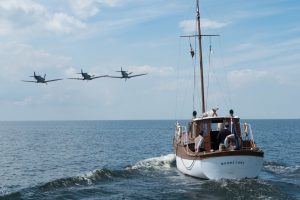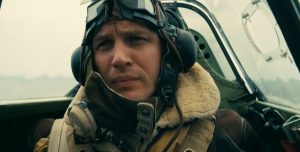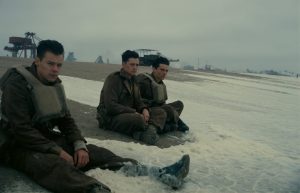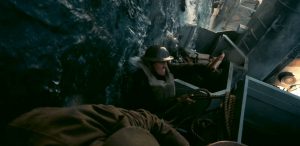![]()
A word of warning to anyone with a fear of drowning… Dunkirk may send you right over the edge. In fact, the latest from director Christopher Nolan (The Prestige, The Dark Knight, Inception, Interstellar) has so much water-based danger that the movie may create some new phobias. Tense, thrilling and even moving, this is an excellent war film. It’s one of the best of its kind in recent memory.
 For those unfamiliar with the subject matter, in May, 1940, the German military were advancing well into France, flanking and beating back the Allied Army. Taking heavy losses, the Allies found themselves trapped on the beaches of Dunkirk, with little else to do but wait until they met their end or, best case scenario, be taken prisoner. They and the rest of Europe would have likely been completely seized by the Nazi army at this point in history, were it not for a ramshackle evacuation effort involving both military and small civilian boats that sailed across the channel to help rescue the stranded soldiers. Miraculously, they managed to pull out over 338,000 people.
For those unfamiliar with the subject matter, in May, 1940, the German military were advancing well into France, flanking and beating back the Allied Army. Taking heavy losses, the Allies found themselves trapped on the beaches of Dunkirk, with little else to do but wait until they met their end or, best case scenario, be taken prisoner. They and the rest of Europe would have likely been completely seized by the Nazi army at this point in history, were it not for a ramshackle evacuation effort involving both military and small civilian boats that sailed across the channel to help rescue the stranded soldiers. Miraculously, they managed to pull out over 338,000 people.
 These facts are important to remember because the film itself doesn’t spend any time with boardroom meetings, exposition or explanations of the maneuvers to audiences. In fact, there’s a bare minimum of dialogue here, with most of the character development provided through action. While deceptively simple in some respects, the story is still presented in a complex manner. There are three separate plotlines loosely connected. One involves young soldiers (including Fionn Whitehead and Harry Styles) trapped on the beaches and desperate for rescue. Another involves a pair of Spitfire pilots (Tom Hardy and Jack Lowden) fighting in the sky overhead. The third involves a civilian vessel sailor (Mark Rylance) and crew attempting to help in the rescue efforts.
These facts are important to remember because the film itself doesn’t spend any time with boardroom meetings, exposition or explanations of the maneuvers to audiences. In fact, there’s a bare minimum of dialogue here, with most of the character development provided through action. While deceptively simple in some respects, the story is still presented in a complex manner. There are three separate plotlines loosely connected. One involves young soldiers (including Fionn Whitehead and Harry Styles) trapped on the beaches and desperate for rescue. Another involves a pair of Spitfire pilots (Tom Hardy and Jack Lowden) fighting in the sky overhead. The third involves a civilian vessel sailor (Mark Rylance) and crew attempting to help in the rescue efforts.
 The events themselves took place over a series of days and some segments occur over different timelines. As a result, there’s a lot of cross-cutting between them with the occasional intersecting characters. It’s actually a very clever story approach, keeping one’s brain engaged and busy piecing together where and when things are happening. It also helps add a feeling of unease and tension to events. It’s made even more eerie by the fact that while the leads are constantly being attacked, there are no actual Germans soldiers even visible.
The events themselves took place over a series of days and some segments occur over different timelines. As a result, there’s a lot of cross-cutting between them with the occasional intersecting characters. It’s actually a very clever story approach, keeping one’s brain engaged and busy piecing together where and when things are happening. It also helps add a feeling of unease and tension to events. It’s made even more eerie by the fact that while the leads are constantly being attacked, there are no actual Germans soldiers even visible.
The leads are often confused as to what is going on and placing audiences in the middle of this uncertainty within specific groups makes the events feel intimate and relatable. Through the unfortunate circumstances, there are numerous examples of fear, panic and heroism, sometimes all mixed within the same scene. It doesn’t come across as forced or inauthentic and eventually engages on a surprisingly emotional level despite the lack of onscreen conversing.
 Technically, it’s stunning as well. Most of the film was shot in 70mm IMAX, adding a sense of crystal clear spectacle and epic scope. Viewers get to fly with the Spitfires high in the sky (it seems that while a few digital elements have been added, a lot has of what is featured has been done for real), witness the hundreds of thousands of soldiers lining the beaches and feel a sense of claustrophobia along with the characters as ships capsize and sink. The metallic, clanging score adds a further element of anxiety to the proceedings.
Technically, it’s stunning as well. Most of the film was shot in 70mm IMAX, adding a sense of crystal clear spectacle and epic scope. Viewers get to fly with the Spitfires high in the sky (it seems that while a few digital elements have been added, a lot has of what is featured has been done for real), witness the hundreds of thousands of soldiers lining the beaches and feel a sense of claustrophobia along with the characters as ships capsize and sink. The metallic, clanging score adds a further element of anxiety to the proceedings.
So while elements are familiar, this is a surprisingly unique take on a war film. It moves at an incredibly quick clip and doesn’t appear to waste a frame, never letting up through the entirety of the running time. Personally, I’m not a war film aficionado, but Dunkirk is about as good as it gets. This one stands apart from others of its ilk as an exceptionally well made and new take on the format that continually captivates.


